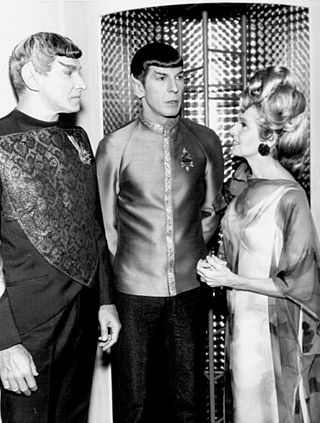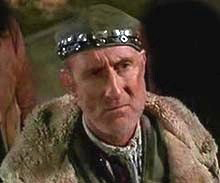The fictional technology in Star Trek has borrowed many ideas from the scientific world. Episodes often contain technologies named after or inspired by real-world scientific concepts, such as tachyon beams, baryon sweeps, quantum slipstream drives, and photon torpedoes. Some of the technologies created for the Star Trek universe were done so out of financial necessity. For instance, the transporter was created because the limited budget of Star Trek: The Original Series (TOS) in the 1960s did not allow expensive shots of spaceships landing on planets.

Star Trek: First Contact is a 1996 American science fiction film directed by Jonathan Frakes in his feature film debut. It is the eighth movie of the Star Trek franchise, and the second starring the cast of the television series Star Trek: The Next Generation. In the film, the crew of the starship USS Enterprise-E travel back in time from the 24th century to the 21st century to stop the cybernetic Borg from conquering Earth by changing the past.
Starfleet is a fictional organization in the Star Trek media franchise. Within this fictional universe, Starfleet is a uniformed space force maintained by the United Federation of Planets as the principal means for conducting deep space exploration, research, defense, peacekeeping, and diplomacy. While most of Starfleet's members are human and it has been headquartered on Earth, hundreds of other species are also represented. Most of the franchise's protagonists are Starfleet commissioned officers.

Vulcans, sometimes referred to as Vulcanians, are a fictional extraterrestrial humanoid species in the Star Trek universe and media franchise. In the various Star Trek television series and films, they are noted for their attempt to live by logic and reason with as little interference from emotion as possible. Known for their pronounced eyebrows and pointed ears, they originate from the fictional planet Vulcan. In the Star Trek universe, they were the first extraterrestrial species to make contact with humans.

In the fictional universe of Star Trek, the United Federation of Planets (UFP) is the interstellar government with which, as part of its space force Starfleet, most of the characters and starships of the franchise are affiliated. Commonly referred to as "the Federation", it was introduced in the original Star Trek television series. The survival, success, and growth of the Federation and its principles of freedom have become some of the Star Trek franchise's central themes.

Jonathan Archer is a fictional character in the Star Trek franchise. He is one of the protagonists of the television series Star Trek: Enterprise, where he was portrayed by Scott Bakula.

Sarek is a fictional character in the Star Trek media franchise. He is a Vulcan astrophysicist, the Vulcan ambassador to the United Federation of Planets, and father of Spock. The character was originally played by Mark Lenard in the episode "Journey to Babel" in 1967. Lenard later voiced Sarek in the animated series, and appeared in Star Trek films and the series Star Trek: The Next Generation.
"Broken Bow" is the two-part series premiere of the science fiction television series Enterprise. It originally aired as a double-length episode, but was split into two parts for syndication, though releases on home media and streaming maintain its original one-episode format. A novelization of the episode, written by Diane Carey, was published in 2001. The episode won the 2002 Emmy Award for Outstanding Special Visual Effects for a Series, and was also nominated for sound editing and make-up.

"Journey to Babel" is the tenth episode of the second season of the American science fiction television series Star Trek. Written by D. C. Fontana and directed by Joseph Pevney, it was first broadcast on November 17, 1967.
This article discusses the fictional timeline of the Star Trek franchise. The franchise is primarily set in the future, ranging from the mid-22nd century to the late 24th century, with the third season of Star Trek: Discovery jumping forward to the 32nd century. However the franchise has also outlined a fictional future history of Earth prior to this, and, primarily through time travel plots, explored both past and further-future settings.

The USS Enterprise NCC-1701-E is a fictional starship belonging to the United Federation of Planets, commonly known as the Federation, in the Star Trek franchise. It appears in the films Star Trek: First Contact, Star Trek: Insurrection and Star Trek: Nemesis, where it serves as the primary setting. It is the sixth Federation starship to carry the name Enterprise. The ship's captain during the 2370s and early 2380s was Jean-Luc Picard. He was transferred to the Enterprise-E after the Enterprise-D was destroyed in The Next Generation spin-off movie Star Trek Generations.
"Metamorphosis" is the ninth episode of the second season of the American science fiction television series Star Trek. Written by Gene L. Coon and directed by Ralph Senensky, it was first broadcast on November 10, 1967.
"In a Mirror, Darkly" is the eighteenth and nineteenth episodes of the fourth season of the American science fiction television series Star Trek: Enterprise, and originally aired on April 22 and 29, 2005. This installment was developed to be a sequel to The Original Series episode "The Tholian Web" and a prequel to "Mirror, Mirror". The decision to set an Enterprise episode in the mirror universe originated with a pitch to enable William Shatner to appear in the series. The teleplays for both parts of the episode were written by Mike Sussman, with Manny Coto contributing the story for the second part.
"First Flight" is the fiftieth episode of the American science fiction television series Star Trek: Enterprise, the twenty-fourth episode of the second season. It first aired on May 14, 2003, on UPN. It was written by John Shiban and Chris Black, and was directed by Star Trek: The Next Generation actor LeVar Burton.
"Future Tense" is the 42nd episode of the television series Star Trek: Enterprise, the 16th of the second season. Set in the 22nd century of the Star Trek universe, a spaceship and its crew deal with aliens as they explore space.
"Homestead" is the 169th episode of Star Trek: Voyager and the 23rd episode of the seventh season. One of the final episodes of the series, it marks the departure of Neelix from the crew of the Starship Voyager.

Federation (1994) is a science fiction novel written by Judith and Garfield Reeves-Stevens. It is a tie-together chronicle that brings the original Enterprise adventures of James T. Kirk close to an encounter with the Enterprise-D adventures of Jean-Luc Picard.
Several characters within the Star Trek franchise, primary and secondary, often made crossover appearances between one series and another. This included appearances of established characters on premiere episodes of new series, a few long-term transfers from one series to another, and even crossovers between Trek films and television. A few crossover appearances, such as that of Spock on The Next Generation and the time-travel of the crew of Deep Space Nine to the era of The Original Series were especially lauded by both fans and critics.
The following outline is provided as an overview of and topical guide to Star Trek:









